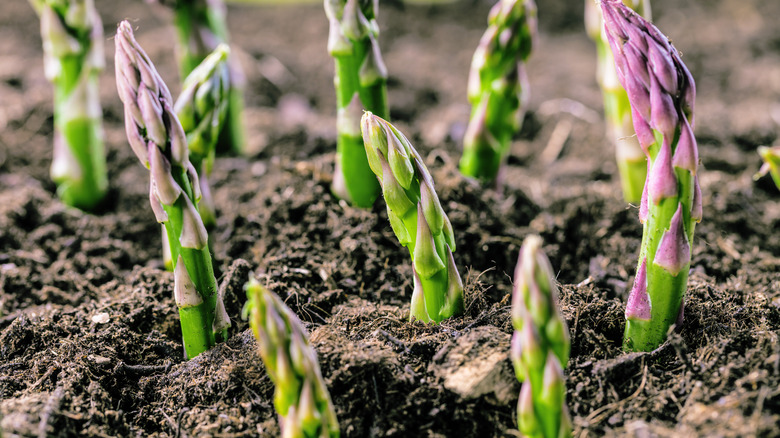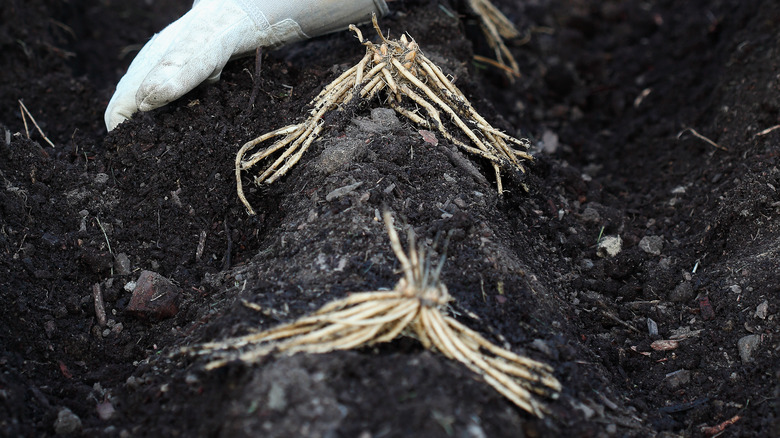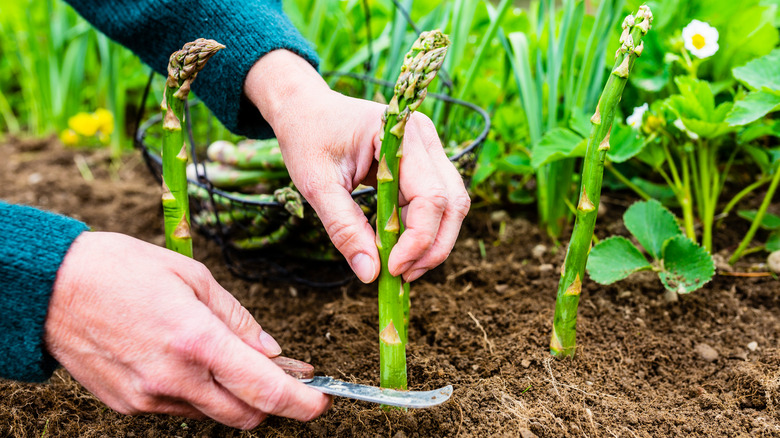The Best Time To Plant Asparagus For A Delicious Harvest
If you've never grown asparagus, you may want to start. It's one of the most incredible plants to grow, providing a continual harvest throughout early summer. This plant can produce a remarkable 2 inches daily with a harvesting season lasting up to 2 months. You can go outside almost every day and find harvest-ready asparagus waiting for you. It's also a perennial, meaning that once it's established, it will return year after year. Asparagus is typically planted in the spring but can also be planted in the fall.
If grown from crowns (the one-year-old roots of asparagus), asparagus takes about two years to become fully established and ready to harvest. If growing asparagus from seed, you can start harvesting around the third year. This is because it takes around three years for asparagus to mature. Whatever you choose, keep in mind that it's a long-term plant that can continue to produce for 15 years or more.
What month do you plant asparagus?
The best months to plant asparagus are April, May, or early June. You can also plant it in the late fall while the soil is still warm, which gives the asparagus more time to become established. Asparagus also needs a dormant period, which happens in cold weather. This period allows for the production of the crowns and roots, so you have a strong asparagus crop when it comes time to harvest.
The most popular way to plant asparagus is from crowns since they've already had a year of growth. When planting the crowns, you must first dig a trench, leaving at least 1-foot length-wise for each crown. The depth will depend on your soil type. Stick between 6 and 8 inches for poorly-draining clay soils and 10 to 12 inches for sandy, well-draining soil. Place the crowns in the trench head-to-toe in a line. You don't need to spread the roots out. Cover them with 2 to 3 inches of soil and water them. Make sure you keep them moist and don't let them dry out. After 2 to 3 weeks, you'll have tiny asparagus spears that should be a few inches tall. Throughout the summer, gradually add a few more inches of soil. Once the entire trench is backfilled, the top of the crowns should be around 6 inches below the surface.
Soil quality and timing of asparagus planting
Ensuring your soil's pH, nutrient levels, and moisture content are all at the proper levels before planting can help set your asparagus up for maximum productivity and healthy growth throughout the year. While the process of planting asparagus may seem daunting, it's a great vegetable that's worth the wait. Add it to your garden in the early spring or fall for bountiful harvests year after year.
Asparagus grows best in non-acidic soils with a pH between 6.5 and 7. To measure your soil's pH, you'll use a pH tester. These are available at Home Depot for around $12. This 3-in-1 tester also measures soil moisture and light. Asparagus also does best in well-draining soils with lots of nutrients and water. An all-purpose, balanced fertilizer should do the trick if you need to add nutrients to your soil. You can find an all-purpose fertilizer online at MIgardener for $21. This 6-pound bag of fast-acting, slow-release fertilizer helps with flower production, root growth, and plant health and creates larger, nutrient-rich vegetables. If you need clarification on whether your garden needs a boost or is suffering from nutrient deficiencies, look for signs like yellowing leaves, burnt leaf edges, stunted and dying leaves, and plant deformities.


